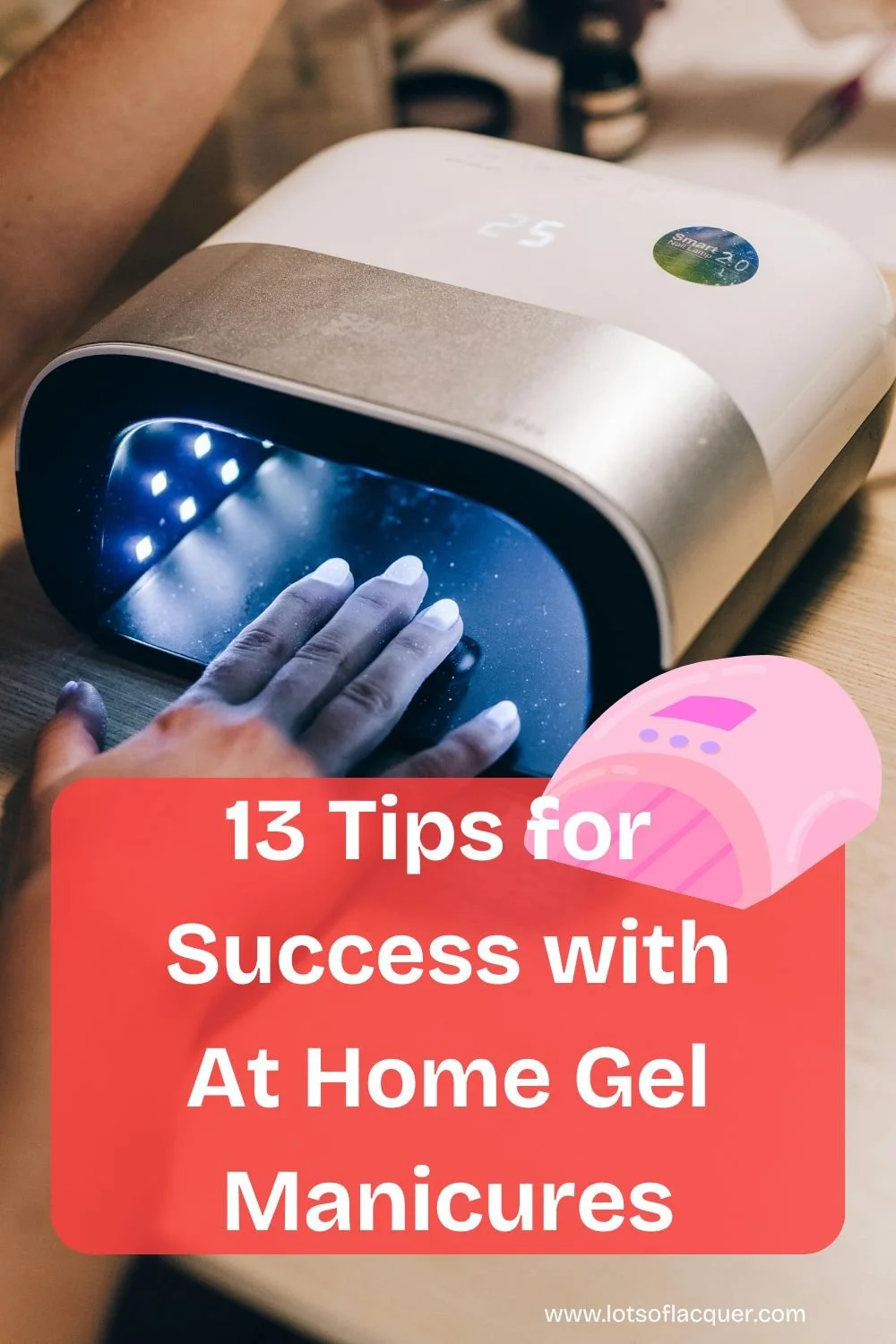13 Tips for Success with At Home Gel Manicures
Updated 2025.09.12. This post contains affiliate links. If you buy something through these links, I may earn a commission at no extra cost to you. As an Amazon Associate I earn from qualifying purchases.
When you dive into gel manicures, the first thing you’ll notice is the formula is different from nail polish.
Gel polish is thicker and stickier. You have more time to move it around before it dries.
You can play with it to get it into place and then, set it in the lamp to cure.
You don’t have to rush with gel like you do with nail polish.
One caveat of that is gel polish will pre-cure when exposed to sunlight.
As you’ll see below, you want to do your nails out of direct sunlight, but other than that, it’s pretty forgiving once you get the hang of it.
There is a learning curve, but it’s short.
It took me 3 tries to get my first gel manicure right. It may take you less time.
Also, after 4 years of focusing on mostly nail polish, starting to work with gel manicures took me some time.
If you research gel manicures, you may come to notice information out there regarding some people having an allergic reaction to them.
It’s true some gel polishes contain sensitizing ingredients, specifically TPO or HEMA can be an allergen, but they’re not exclusive to nails - these chemicals are used in industrial, medical, dental and beauty products.
If you are similarly concerned about a HEMA or another allergy, you could try a patch test yourself or to avoid stimulating an allergy, try curing the gel on 1 nail whilst minimizing skin contact, before going forward with a full manicure.
One thing I like to do is buy a small amount of the product to see how I respond before going whole hog on any brand.
If you do notice redness or any signs of an allergic reaction at any point — remove the polish and discontinue use.
Shift to other brands that are TPO or HEMA-free before giving up on gel. And if you’re still unsure, don’t hesitate to consult with your doctor or allergy specialist.
The next step was deciding a gel brand to start with.
You can choose any gel polish brand that appeals to you to get started or you do what I did - start where you are, use what is readily available to you and expand from there.
Below you’ll find 13 tips for success with an at home gel manicure:
1. Prep your nails really well
If you’re wondering how to prep your nails for a gel manicure, you’re in luck.
It’s the same as prepping your nails for any manicure - except for 1 step, adding sunscreen.
To prep your nails before your manicure:
Remove your old nail polish, buff your nails, wash your hands, apply sunscreen to protect your hands from any UV rays from the lamp and clean your nails with alcohol.
The better your nail prep, the better your gel polish will adhere and the longer your nails will last.
2. Follow the instructions for curing time
How long it takes for your gel polish to cure will depend on your lamp and your formula.
Each lamp and formula will have different instructions for curing time, due to the lamp’s wattage, the formula’s thickness, color density and more.
Read these instructions carefully. For example, a base or top coat may need 90 seconds, while a color coat may need 60 seconds.
If there is a curing range, like 60-90 seconds, choose the maximum end of the range.
Be sure to cure each coat for no more than the max recommended time needed for each formula type - gel polish can wrinkle or become brittle when over-cured.
You want to ensure that your manicure is fully cured, but you don’t want to expose yourself to more UV light than necessary to get the job done.
3. Keep gel bottles away from the UV/LED lamp when it’s running
When curing, keep your gels away from the lamp, ideally on the other side of your nail desk, otherwise the UV light may cure the formula in your bottles as the lamp runs.
4. Seal your gel polish bottle after each coat
As you cure each coat, keep the gel sealed so that any exposure to ambient UV light and air is minimized.
If you don’t do this, your formula could thicken in the bottle, shortening its lifespan.
5. Don’t do your nails in direct sunlight
The ambient UV rays will slightly cure the gel and make your gels chunky as you apply them, creating ripples in your polish before you cure it and thus curing your gel manicure prematurely.
But it's not just the polish itself.
The gel polish can semi-cure on the polish brush built into the bottle cap, causing the bristles to stiffen and dry up.
If this happens to you, you’re in a shared company - I’ve made this mistake before! Shake it off and move on.
6. Remove excess gel on your skin with alcohol/acetone before curing
Using a clean up brush, inspect the skin around your nails for excess gel before putting your hand in the lamp.
Otherwise the gel will bake onto the skin, making it difficult to remove.
If gel does harden on the skin, though, you’re probably fine.
During your next shower (which should be no earlier than 24 hours after your manicure) your skin softens and any hardened gel comes right off.
7. Don’t let gel polish pool on the nail or near the cuticle
If you notice thicker pools of gel anywhere on the nail, go back over it with an empty brush to pick up the excess and return it back to the bottle.
If gel pools into the cuticle, it could cause your gel to peel or cure unevenly, so clean that up before placing it in the lamp.
If you notice this happening repeatedly, try a cream gel.
8. Apply thin coats
Thin coats are best. It helps the gel cure evenly.
This may take practice as gel is thicker than regular polish, but you can get there.
You can ensure thinner coats by wiping off 1 side of the brush and only paint with the 1 side of the brush that has a bead of gel.
Both sides of the brush should not have gel on it.
9. Cap the free edge
Gel polish shrinks as it cures.
Because of this, you’ll want to ensure you cap the free edge of your nail with gel polish and get your gel polish as close to the cuticle line as possible without it touching the skin.
One way to get the gel close to the cuticle line, without touching the skin, is by placing the gel brush in the middle of the nail and pushing it up towards the nail line.
This works better than trying to start close to the cuticle line with a brush filled with polish.
10. Get a higher wattage lamp
If you get a lower wattage lamp and it works fine for you, great. Change nothing.
But, if you notice your gel polish isn’t curing all the way, return the lower wattage lamp to the store and replace it with a higher wattage version.
Lower wattages may not cure all gels, all the way through.
11. Use the same brand
When possible, use the same brand throughout - base, top, gel color, lamp.
This ensures all products work together in harmony - both chemically in the formula and with the proper wavelength of light to cure that specific gel being applied.
12. Wash your hands after you’re done
Before washing your hands in the sink, it’s worth noting that in the gel polish world there are two types of top coats; wipe and no-wipe.
No wipe top coats don’t require you to finish your manicure with a nail cleanser, and these are the top coats you’ll use to encapsulate chrome.
Once you have cleansed (or not cleansed) your gel manicure -
Washing your hands will help ensure that no manicure solvent (acetone or alcohol) residue remains.
Moisturize and apply cuticle oil for the final touch.
13. Soak your gel manicure in acetone for removal
To remove your gel nails easily, keep hot water in mind. Hot water speeds up acetone’s process.
To remove your gel manicure, fill up a glass or stainless steel bowl with hot water, and in it place a double plastic bag filled with acetone.
File off the shiny surface of your gel manicure and then dip your nails in the warm acetone for 5-10 minutes.
Scrape off the gel over a trash can with a cuticle pusher.
The gel should crumble off and you should be able to do it without a lot of force. If you notice you need force, continue to soak.
So there you have it!
13 tips that can make your at home gel manicure a success. If you don’t get it right the first time, please don’t give up.
Notice what improvements you can make to your process and keep going.
It took me 3 tries to get the swing of it. I’m glad I kept at it until I reached success. Getting a gorgeous gel manicure on the 3rd try was really satisfying and yes, it was worth suffering through the mistakes.
To end, I’m glad to be moving into my gel manicure era.
I still love nail polish and will be alternating between the two, still, I’m looking forward to embracing longer lasting manicures that maintain their shine for weeks to come!
To manicures that last ~
Want to know what I’m currently loving in the gel polish world? Check out my gel polish recommendations on this page.
Other Articles You May Enjoy:
Amazon and the Amazon logo are trademarks of Amazon.com, Inc. or its affiliates. As a Beyond Polish Brand Ambassador, this site earns from qualifying purchases. Use coupon code LOTSOFLACQUER for 10% OFF at Beyond Polish! As an Aimeili Affiliate, this site earns from qualifying purchases. Use coupon code LOTSOFLACQUER for 10% OFF at Aimeili!



